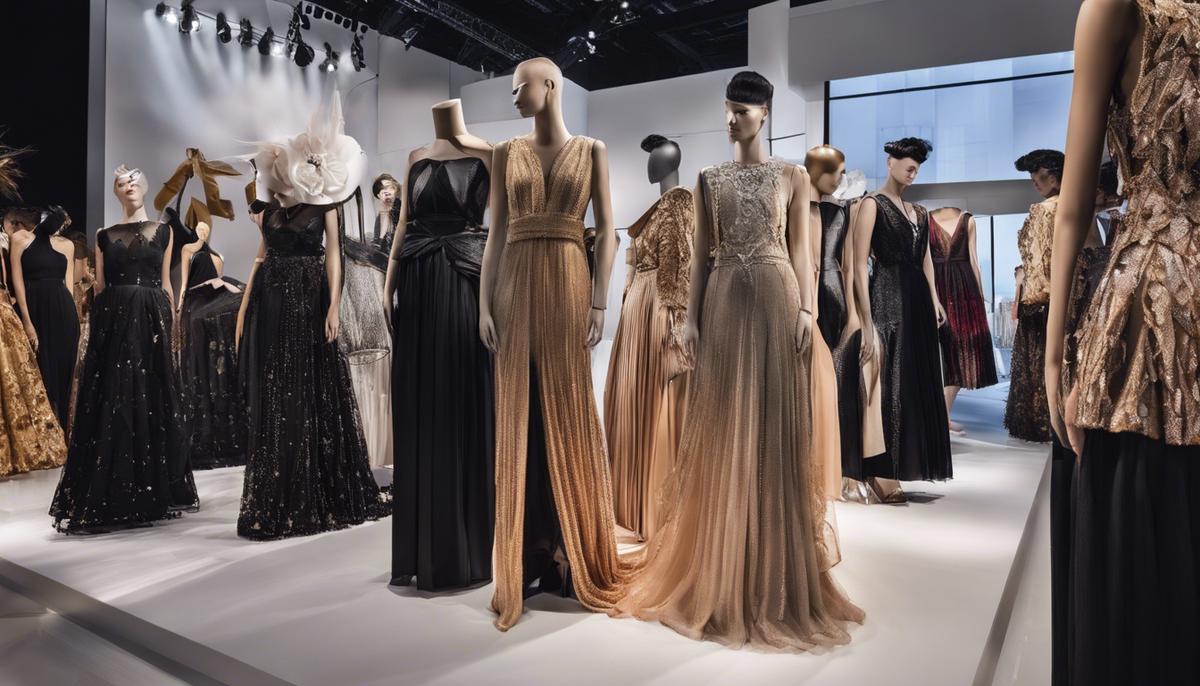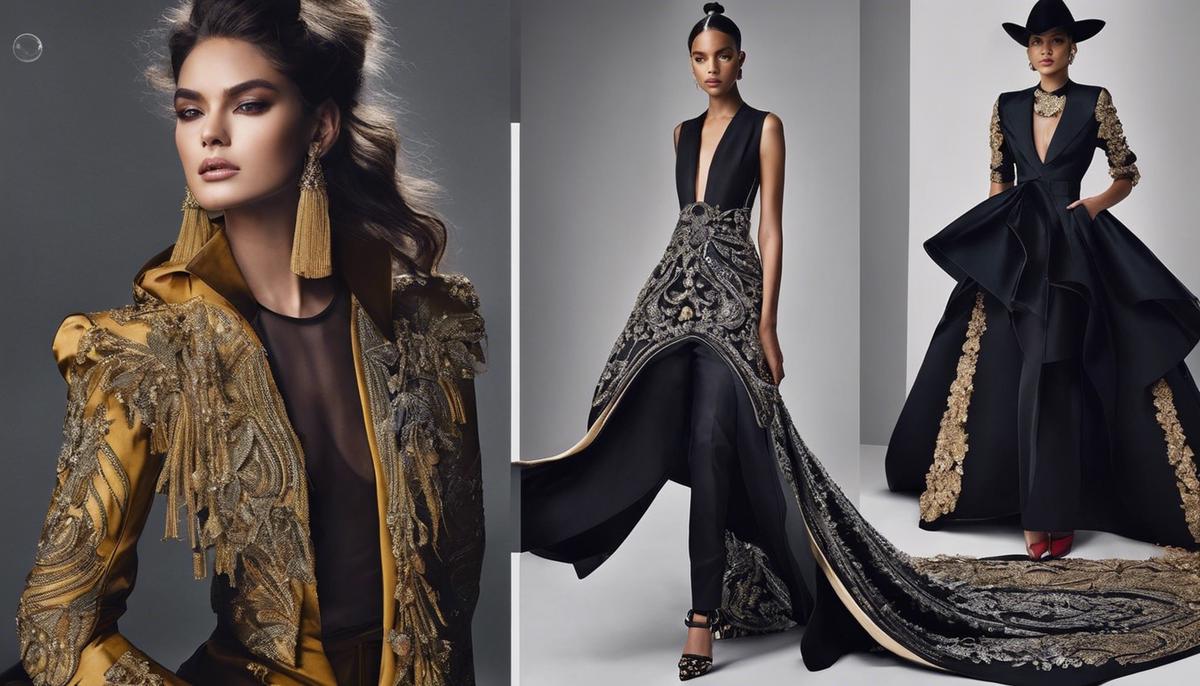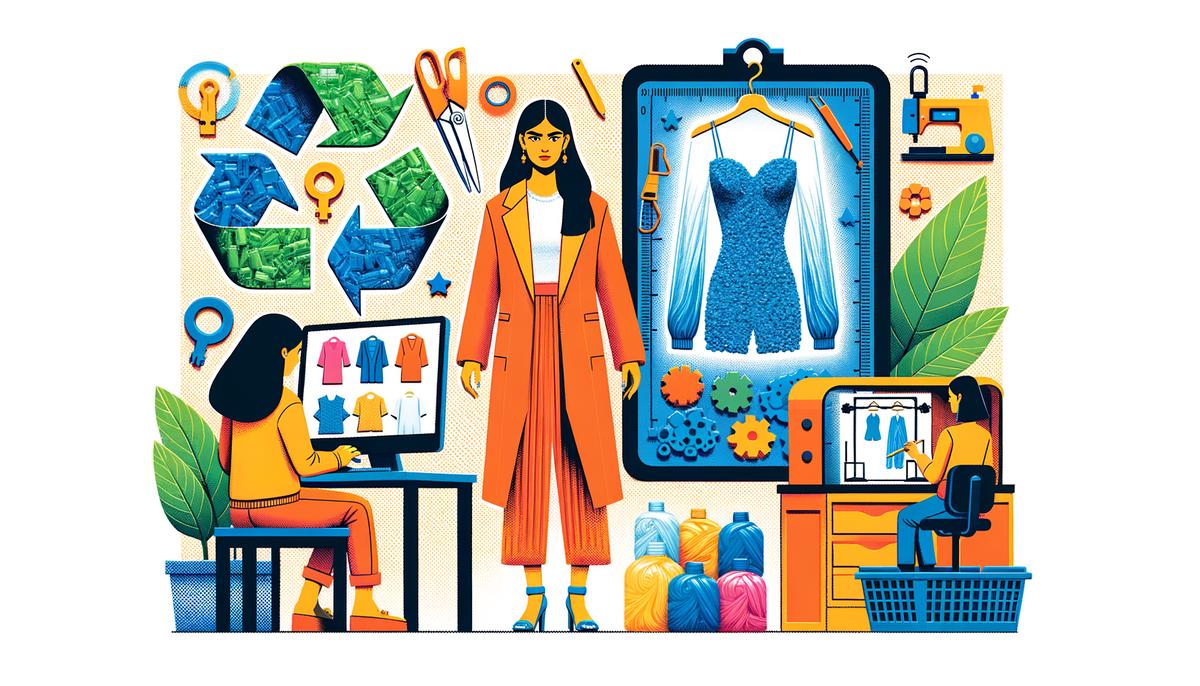The world of fashion stands at a crossroads, where the shimmer of high fashion collides with the dynamism of fast fashion. In one realm, high fashion, or haute couture, reigns with its revered traditions of craftsmanship, exclusivity, and exorbitant price points. It’s an echelon that speaks to the artistry of apparel, where garments are not merely worn, but experienced. On the opposing end lies fast fashion, an industry titan known for its rapid production cycles, trend-centric designs, and highly accessible price tags, embodying the pace of modern consumerism. Together, these two contrasting models weave the intricate tapestry of today’s fashion narrative, each with its unique set of industry standards and consumer expectations that influence global sartorial choices.
Defining High Fashion and Fast Fashion
High Fashion vs. Fast Fashion – Decoding the Buzz
In the grand tapestry of modern commerce, fashion stands out as a dynamic, ever-changing industry that profoundly impacts global markets and cultural trends. However, there’s a line in the sand between high fashion and fast fashion that often blurs for the uninitiated. It’s critical to understand the chasm that separates the two, as they cater to vastly different markets and embody divergent business models and consumer values.
First up, high fashion – the crème de la crème of creativity and craftsmanship. We’re talking about the likes of Chanel, Prada, and Dior here, where exclusivity and luxury reign supreme. High fashion is characterized by limited edition runs, meticulous attention to detail, and often hand-crafted designs that come with a hefty price tag. These pieces are not merely clothing; they’re a statement, an art form, worn by those who consider their wardrobe a reflection of prestige and refined taste. High fashion is about setting trends, not following them, and it’s tailored for the elite who value originality and the highest standards of quality.
Now, pivot to the other end of the spectrum: fast fashion, think Zara, H&M, and Forever 21. Here is where accessibility and time reign. Fast fashion takes inspiration from catwalks and celebrity styles and turns them into affordable apparel at breakneck speed. Its primary goal is to get the latest designs into stores quickly, usually at a price that makes them accessible to the masses. This model thrives on high volume and fast turnover, feeding the consumer’s desire for fresh, trendy, and reasonably priced items that can be worn for a season and then discarded without guilt.
At its core, the distinction between high fashion and fast fashion boils down to quality versus quantity, timeless craftsmanship versus trendy immediacy, and exclusivity versus accessibility. High fashion invests in the longevity of a brand through enduring styles and substantial quality, while fast fashion capitalizes on the fleeting whims of current trends.
What’s critical for anyone with an eye on business trends is the understanding that while high fashion and fast fashion may cater to different consumers, both sectors have significant impacts on global economics and sustainability. This creates avenues for innovation and new market opportunities that can bridge the gap, incorporating sustainable practices and tech advancements. Savvy entrepreneurs and consumers alike are starting to demand both style and substance, paving the way for a new breed of fashion that redefines what our clothes mean to us and to the environment.
In a world where one can choose between the exclusivity of a Paris runway piece or the instant gratification of off-the-rack retail fashion, each consumer’s choice shapes the future of the industry. And in this industry, the only constant is change.

The Business Models of High and Fast Fashion
Title: Decoding the Business Models: High Fashion’s Elegance vs. Fast Fashion’s Efficiency
In the competitive arena of clothing retail, high fashion and fast fashion exist on opposite ends of the spectrum. The former thrives on legacy, rarity, and high-end craftsmanship, while the latter hinges on rapid production, trend replication, and high turnover. Both offer unique value propositions, but they navigate the market with their distinct strategies.
High fashion houses operate on a model of scarcity and luxury, often releasing limited quantities to maintain a sense of exclusivity and demand. Brands like Chanel and Hermès exemplify this approach, creating timeless pieces that double as investments. The narrative is about history, art, and a deep connection to cultural sophistication that resonates with affluent consumers who seek status symbols and heirlooms.
Conversely, fast fashion retailers like Zara and H&M capitalize on a high-volume, low-margin strategy that brings catwalk trends to the mass market at breakneck speed. Their agile supply chains and data-driven designs allow quick adaptation to changing consumer tastes. Fast fashion’s primary draw is its ability to offer an ever-revolving wardrobe mirroring the latest styles at an affordable price point, making trendiness accessible to the everyday shopper.
The business models of these two fashion giants diverge in their approach to inventory as well. High fashion labels curate seasonal collections presented at exclusive events, aligning their release with fashion weeks around the globe. Inventory is tightly controlled, ensuring that each piece retains its value over time. On the other hand, fast fashion operates on a see-now-buy-now model, with new inventory landing in stores and online virtually weekly, feeding the consumers’ desire for fresh, on-trend items.
Profitability in high fashion is driven by high price points and brand prestige, while fast fashion profits from volume and repeat purchases. While high fashion leans on heritage and the emotional connection with its customer base, fast fashion is all about instant gratification and variety.
Let’s not overlook the importance of both sectors to the global economy. High fashion commands respect and stimulates various industries including textile production, while fast fashion has embedded itself into the fabric of consumer culture, driving substantial global employment but also raising concerns about ethical practices and environmental impact.
In essence, the divergence of business models between high fashion and fast fashion reflects a broader conversation about value, values, and velocity in the industry. Whether prioritizing quality and exclusivity, or accessibility and immediacy, both business models continuously adapt to the ever-evolving fashion landscape. With innovation at the heart of this sector, visionaries across the continuum strive to anticipate and shape future trends, ensuring that, regardless of pace or price, fashion remains a dynamic and integral expression of culture and personal identity.

Market Demand and Consumer Behavior
Fulfilling the Consumer’s Pulse: The Forces Behind High and Fast Fashion Dynamics
In the intersection of catwalks and street corners lies the pulsating heartbeat of consumer demands driving both high and fast fashion industries forward. Their preferences are clear – they’re seeking the latest trends, but the path they take diverges between desire for premium status symbols and the allure of instant gratification.
High fashion hinges on the allure of scarcity and exclusivity. Brands operating in this niche curate limited-edition collections which evoke a sense of uniqueness, subsequently driving up demand among those craving distinction. The inventory approach is thus meticulously managed to uphold the brand’s luxurious image, ensuring the supply side remains tight and the allure strong.
Contrastingly, fast fashion thrives on a strategy that emphasizes speed to market, replicating haute couture trends with staggering swiftness to satisfy trend-hungry consumers. These brands excel in transforming runway looks into rack-ready pieces at a fraction of the cost. This high-velocity turnover champions the ‘see now, buy now’ culture that aligns with a more impulsive consumer mentality.
Analyzing profitability avenues, both sectors navigate the waters of success but with different compasses. High fashion claims its stakes in higher margins per item, while fast fashion compensates with volume, selling a larger quantity of items at lower margins.
The importance of high and fast fashion extends beyond couture and commerce; it encapsulates a significant segment of the global economy. Together, they not only generate substantial revenue but also offer a spectrum of job opportunities across the globe.
Yet amid profitability, ethical and environmental concerns related to fast fashion are intensifying. The relentless pace of production and disposal cycle has raised red flags about sustainability. These pressing issues ignite discussions on value and values, encouraging both consumers and companies to consider the environmental velocity of their fashion footprints.
The broader conversation doesn’t end there. As society becomes more conscientious, the fashion industry, both high and fast sectors, must continuously adapt and innovate. This is where technology comes into play, offering solutions such as virtual fitting rooms or AI trend forecasting, which pave the way for smarter inventory management and personalized experiences.
Looking at the cultural landscape through the lens of fashion, one finds an ever-changing tapestry that reflects society’s values, aspirations, and identity. From haute couture to high street, what people wear is a dynamic and integral expression of culture and personal identity.
In conclusion, high and fast fashion are not just about the garments that drape our figures. They are a manifestation of our times, mirroring consumer psychology and societal priorities. As these industries sail ahead, they continue to be shaped by the winds of consumer demand, cultural shifts, and the unyielding force of innovation.

How Can Fast Fashion Brands Incorporate Adaptive Fashion and Redefine Inclusivity?
Fast fashion brands can incorporate adaptive fashion inclusivity redesign by creating clothing lines that cater to people of all body types and abilities. By designing versatile and adjustable garments, these brands can redefine inclusivity and make fashion more accessible to a wider range of customers.
Impact of Fast Fashion on High Fashion
Embracing Change: Fast Fashion’s Ripple Effect on High-End Couture
In the ever-dynamic world of apparel, the high fashion industry is experiencing a seismic shift. The fast fashion phenomenon, with its quick production cycles and prolific trend output, presents a bevy of challenges and opportunities for the stewards of haute couture. Adjusting the sails to navigate these turbulent waters is not just an option but a necessity for survival and success.
As fast fashion brands pump out affordable, runway-inspired pieces at lightning speeds, traditional high fashion houses face the call to reassess their strategies. This rising tide challenges the long-standing notion of season-bound collections – a disruption that is impossible to ignore. The pressure to stay relevant is palpable.
This tension is etched into the fabric of retail practices. High fashion’s once-unquestioned reign on the runway is now a conversation about adaptation. As consumers hungrily consume the latest styles, couture brands eye a diversification of their product lines, infusing a touch of ready-to-wear charm into their prestigious labels.
The coexistence of both sectors underlines a dual reality: exclusivity still reigns supreme for a niche market, while accessibility commands the masses. The luxury segment, while not expanding at the breakneck pace of its counterpart, still reports robust profitability, thanks largely to its unwavering clientele. However, the need to innovate – to blend the exclusivity of high fashion with the agility of fast fashion – sparks a new frontier.
In response, many couturiers are reevaluating their calendar, with some opting for seasonless collections. This shift underscores an evolving consumer mentality that prizes both uniqueness and immediacy – a cultural oxymoron bridged only through innovation.
The push for faster production times in high fashion, however, must not overlook the ethical and environmental ramifications – a critique fast fashion continually confronts. From wastefulness to workplace conditions, the industry looks towards technology and sustainable practices as harbingers of positive change.
Amid these industry upheavals, one thing remains certain: fashion is more than clothing – it’s a powerful expression of culture and identity. Even as fast fashion redefines the rhythm, high-end fashion houses continue to underscore the artistry and emotion behind every design.
Couture and ready-to-wear now sail the same vast ocean of consumer desire. Each, with its distinctive approach to creativity and commerce, must find a way to coalesce art with expectation, longevity with immediacy, and traditional splendor with modern sensibilities.
Thus, the apparel world watches eagerly, poised to see the larger-than-life high fashion domain enact transformation, keeping pace with a society that moves at the speed of social media scrolls. The ultimate question – “What’s next?” – isn’t just for style trends; it’s for the industry’s soul, which hangs in the balance between heritage craftsmanship and the democratization of style. The essence of high fashion need not be compromised; rather, it must be recalibrated for a generation that demands both the ethereal and the instant, a balance as delicate as the needlework on a bespoke suit.

Sustainability and Ethical Considerations
In the intersection of high fashion and fast fashion, sustainability and ethics emerge as twin forces of reckoning, lobbying for a profound reevaluation of practices that have long gone unchecked. Transparency, accountability, and a conscientious supply chain now helm the criteria shaping the influential forces within the fashion zeitgeist.
As players in the market innovate to survive, they’re finding that ecological sustainability isn’t a niche selling point but an industry imperative. The urgency spills from the statistics; the apparel industry accounts for a staggering 10% of global carbon emissions. This jarring figure propels an irrefutable pivot towards green practices. In this new era, sustainable materials are not just an afterthought but the scaffolding upon which new collections are constructed. The alignment of ethical labor practices, recyclable materials, and reduced carbon footprints is no longer optional; it’s the new default for industry respectability.
Fast fashion, with its model built on unrelenting consumption, finds itself at significant odds with this shift. The previous model of keeping up with the dizzying pace of trends is giving way to the practices of producing less, but better. While the price-point accessibility becomes a velvet rope excluding some consumers, the democratization of fashion through technological advances and resale platforms is creating new entryways.
In turn, high fashion’s operational blueprint, grounded in exclusivity and longevity, is being recast. It’s no longer sufficient to rely on brand heritage and haute couture craftsmanship alone. The modern cognoscenti expect legacy to liaise with leadership in environmental stewardship. A garment’s value is now measured not just by the designer label but by its lifecycle and ethical creation.
The narrative now touts fashion as a steward for environmental and humanitarian advocacy. The emergence of conscious consumerism injects a clarion call to action: the once distant drumbeats of ethical production are now front and center. It’s a rhythm dictating the pace of production cycles, the materials chosen, and the societal imprint left behind. Heavyweight luxury conglomerates and agile fashion startups alike are exploring creative and resourceful avenues to diminish waste and boost sustainability. From mushroom leather to closed-loop recycling, the alchemy of innovation is yielding materials that answer the twin calls of luxury and longevity without forsaking the planet.
Yet, as this landscape morphs, consumers find themselves not only as bystanders but as essential participants. Their choices wield the power to deem a brand’s social currency. The empowered consumer votes with their wallet, endorsing brands that align with their increased scrutiny of sustainability practices and ethical employment.
In summary, the high vs. fast fashion dialectic doesn’t just evolve in a vacuum—it’s a reflection of global citizenship, a quest for a reconciled coexistence of aesthetics, ethics, and ecological concern. As the fashion world weaves its next chapter, the orthodoxy of high fashion merged with a recalibrated fast fashion paradigm hints at an industry at the cusp of renaissance—a renaissance that dawns with the threads of hope, woven with the resilient fibers of change.

As the fashion industry continues to evolve, the dialogue between high fashion and fast fashion remains a complex interplay of art, commerce, and ethics. The contrast between meticulously crafted couture pieces and swiftly produced trendsetters is emblematic of a sector that is multifaceted and ever-changing. Yet, amid these differences, the commitment to sustainability and ethical practices emerges as a unifying force, challenging designers and corporations alike to envision a future where beauty and responsibility converge seamlessly. Ultimately, the power resides with consumers, whose preferences and principles will shape the trajectory of fashion in the years to come, melding timeless elegance with contemporary consciousness.










